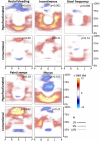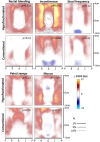Local Dose Effects for Late Gastrointestinal Toxicity After Hypofractionated and Conventionally Fractionated Modern Radiotherapy for Prostate Cancer in the HYPRO Trial
- PMID: 32346534
- PMCID: PMC7169424
- DOI: 10.3389/fonc.2020.00469
Local Dose Effects for Late Gastrointestinal Toxicity After Hypofractionated and Conventionally Fractionated Modern Radiotherapy for Prostate Cancer in the HYPRO Trial
Abstract
Purpose: Late gastrointestinal (GI) toxicity after radiotherapy for prostate cancer may have significant impact on the cancer survivor's quality of life. To date, little is known about local dose-effects after modern radiotherapy including hypofractionation. In the current study we related the local spatial distribution of radiation dose in the rectum to late patient-reported gastrointestinal (GI) toxicities for conventionally fractionated (CF) and hypofractionated (HF) modern radiotherapy in the randomized HYPRO trial. Material and Methods: Patients treated to 78 Gy in 2 Gy fractions (n = 298) or 64.6 Gy in 3.4 Gy fractions (n = 295) with available late toxicity questionnaires (n ≥ 2 within 1-5 years post-treatment) and available 3D planning data were eligible for this study. The majority received intensity modulated radiotherapy (IMRT). We calculated two types of dose surface maps: (1) the total delineated rectum with its central axis scaled to unity, and (2) the delineated rectum with a length of 7 cm along its central axis aligned on the prostate's half-height point (prostate-half). For each patient-reported GI symptom, dose difference maps were constructed by subtracting average co-registered EQD2 (equivalent dose in 2 Gy) dose maps of patients with and without the symptom of interest, separately for HF and CF. P-values were derived from permutation tests. We evaluated patient-reported moderate to severe GI symptoms. Results: Observed incidences of rectal bleeding and increased stool frequency were significantly higher in the HF group. For rectal bleeding (p = 0.016), mucus discharge (p = 0.015), and fecal incontinence (p = 0.001), significant local dose-effects were observed in HF patients but not in CF patients. For rectal pain, similar local dose-effects (p < 0.05) were observed in both groups. No significant local dose-effects were observed for increased stool frequency. Total rectum mapping vs. prostate-half mapping showed similar results. Conclusion: We demonstrated significant local dose-effect relationships for patient-reported late GI toxicity in patients treated with modern RT. HF patients were at higher risk for increased stool frequency and rectal bleeding, and showed the most pronounced local dose-effects in intermediate-high dose regions. These findings suggest that improvement of current treatment optimization protocols could lead to clinical benefit, in particular for HF treatment.
Keywords: NTCP; dose-surface maps; gastrointestinal toxicity; hypofractionation; prostate cancer; radiotherapy.
Copyright © 2020 Heemsbergen, Incrocci, Pos, Heijmen and Witte.
Figures



References
LinkOut - more resources
Full Text Sources
Research Materials
Miscellaneous

